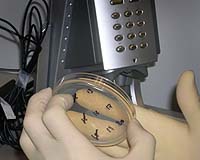 |
Rhinebeck, N.Y. (UPI) Jul 17, 2009 Owners of an upstate New York human-potential retreat center's new building say it may become the world's first "living building." The $3.5 million Omega Center for Sustainable Living at the Omega Institute for Holistic Studies in Rhinebeck, N.Y., goes way beyond "green," Omega said. The one-story, 6,250-square-foot building, inaugurated Thursday, takes "a whole systems approach" and uses "integrative design," Omega Chief Executive Officer Skip Backus said. "Right now, most people think of 'green' as a compact-fluorescent bulb and a (Toyota) Prius (hybrid car), but this building is intended to represent a cultural shift," he told United Press International. It represents a change in basic assumptions, recognizing the interconnectedness of systems, he said. Omega's carbon-neutral building, designed by BNIM Architects of Kansas City, Mo., is heated and cooled using geothermal systems, which use the earth as a heat source in the winter and as a coolant in the summer. Solar panels fill the building's electrical needs, powering computers, air-conditioning, lighting and water pumps, Omega said. The center also includes a greenhouse, constructed wetlands and a water-filtration system that uses plants, bacteria, algae, snails and fungi to recycle Omega's 5 million annual gallons of wastewater into clean water that then restores an aquifer. Omega seeks to have the center certified through the "living building challenge" by the International Living Building Institute, Backus said. The certification, considered the most stringent green building rating in the world, declares that the building is self-sufficient, produces all the energy it consumes and uses and replenishes all the water that lands on its site, institute research director Eden Brukman told UPI. Such a building must also "be restorative," she said. This includes preserving a habitat away from the building site and may also include such strategies as selling electricity back to utilities or reclaiming sewer water for reuse. The Omega center is one of two U.S. buildings that may receive the living building certification next year, Brukman said. The other is the $1.5 million, 2,900-square-foot Living Learning Center at Washington University's Tyson Research Center in Eureka, Mo., which opened May 31. All told, more than 60 projects across North America and three or four elsewhere are pursuing certification, Brukman told UPI. Living building certification standards represent a quantum leap from the U.S. Green Building Council's Leadership in Energy and Environmental Design stamp of approval. LEED certification is a checklist to reduce a building's ecological footprint while living buildings are guided by ideal end results "rather than code-minimum solutions," Brukman said. Backus said the Omega building cost 35 percent to 40 percent more to build than a conventional building but now costs nothing to operate, other than basic maintenance. "No electric bills, no chemical bills," he said. "So the payback, I think, is going to come rather quickly on this." Omega intends for the building to serve as an inspiration for future construction and a center for green-building research and education, Backus said. Share This Article With Planet Earth
Related Links Space Technology News - Applications and Research
 System created to make paper biosensors
System created to make paper biosensorsHamilton, Ontario (UPI) Jul 15, 2009 Canadian scientists say they've created a technology similar to inkjet printing that can be used in making paper-based biosensors to detect harmful toxins. McMaster University Associate Professor John Brennan and his research team say they've developed a method of printing a toxin-detecting biosensor on paper. The biosensor can be used to detect toxins that can cause food poisoning or ... read more |
|
| The content herein, unless otherwise known to be public domain, are Copyright 1995-2009 - SpaceDaily. AFP and UPI Wire Stories are copyright Agence France-Presse and United Press International. ESA Portal Reports are copyright European Space Agency. All NASA sourced material is public domain. Additional copyrights may apply in whole or part to other bona fide parties. Advertising does not imply endorsement,agreement or approval of any opinions, statements or information provided by SpaceDaily on any Web page published or hosted by SpaceDaily. Privacy Statement |